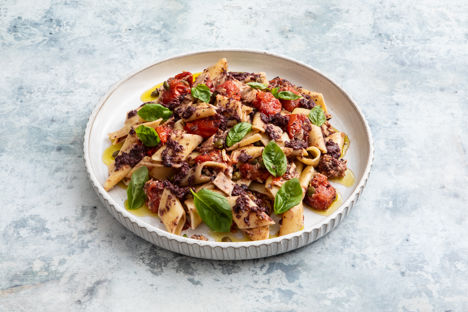Everyone has had at least one bad pasta salad in their life – and probably several. From gloopy, mayonnaise-soaked messes to weirdly gummy plastic-packed lunches, pasta salad has a bit of a mixed reputation. However, they can – and should! – be done well. Here are some of our favourite pasta salad recipes, and a few tips for how to master the dark art of delicious cold pasta.
Most traditional pasta salad recipes (outside of Italy) are fairly heavy on the mayonnaise. In fact, American-style macaroni salad, made with short macaroni, finely chopped carrot, celery, onion and mayonnaise has been around since at least the 1930s, and barely changed as long as mayonnaise and macaroni have co-existed in the United States.
However, while this mayonnaise-rich style of pasta salad is a classic, it’s far from the only choice. If you love the creamy texture of an old fashioned macaroni salad but find mayonnaise too rich, you could also take things in more of a tangy tzatziki direction, and swap out the mayo for full-fat yoghurt.
We also have a recipe for tuna pasta salad (linked below) that doesn't use any mayonnaise at all. Pasta salads don’t need a creamy dressing. Many of our favourite pasta salads use a lemony vinaigrette or homemade pesto instead, or even just a drizzle of olive oil.
While the tuna-sweetcorn-mayo combination that haunts the meal deal section of British supermarkets is decidedly not a Florentine classic, pasta salads are a thing in Italy. Generally called insalata di pasta (pasta salad) or pasta fredda (cold pasta), Italian pasta salads are often served with plenty of mozzarella, cherry tomatoes and basil. They are made in a similar way to the more popular insalata di riso, or rice salad, which is even more popular in Italy than pasta salad is in the UK. Tuna is actually a popular addition in Italy to both rice and pasta salads, but it’s usually paired with olives and tomatoes, rather than sweetcorn and mayonnaise.
Any small pasta works well in pasta salad. Even tiny orzo or fregola works well, although pastina would almost certainly turn to mush. Fusilli, penne and silky mafalda corta are all great choices.
Mayonnaise-based salads are often even tastier if made in advance, and so are a great choice for making a day ahead. Vinaigrette-based salads however will absorb the dressing as they sit, which makes the pasta a little softer. This isn’t necessarily a bad thing, but delicate leaves, lettuces and herbs can go truly soggy if left overnight. These are best added in at the last minute.
How to make pasta salad
Metric
Imperial
- 150g of short pasta
- 1 tbsp of olive oil, plus extra for drizzling
- 8 chipolatas, chicken or pork
- 400g of cherry tomatoes, halved
- 400g of courgette, thinly sliced into rounds
- 15g of basil leaves, torn into large pieces
- salt and pepper
Preheat the oven to 180°C (160°C fan)
Spread the tomatoes, cut-side up, across one baking tray, and the courgettes across another. Drizzle the vegetables lightly with olive oil, and season with flaky sea salt
Roast the tomatoes and courgettes for 45 minutes, rotating the trays after 30 minutes
Once they’re done, the tomatoes should be slightly shrivelled and dark red, and the courgettes should be browned in parts and a little crisp around the edges. Depending on the thickness of your courgettes, and the temperament of your oven, they might need a few more minutes. If some are looking done and others look like they need more time, remove the finished vegetables from the trays and return the others for a few more minutes
While the vegetables are cooking, bring a large pot of salted water to the boil for the pasta
Cook the pasta for about 10 minutes, or until cooked just past al dente
Drain the pasta well, then rinse with water to get rid of any excess starch
Leave the pasta to drain in the colander set over the pan while you cook the sausages, to get rid of any last drops of water
Cook the sausages in a large pan, flipping once they are browned on one side, until they are cooked through and browned all over
Remove the sausages from the heat and transfer them to a chopping board to cool
Transfer the cooled pasta to a large bowl. Mix with the olive oil, and season with salt and pepper. If it’s still clumping up, add a touch more oil
Chop the sausages into thin rounds, and then add to the pasta alongside the vegetables and basil. Mix everything together, then season with salt and pepper to taste, and finish with more olive oil if needed
If you’re making a batch of pasta salad for lunch, it’s safest to use it within a couple of days, especially if you’re including fish or meat, rather than making a batch for the whole week.
Raw ingredients like raw cherry tomatoes and bell peppers don’t freeze well, and mayonnaise’s texture also changes for the worse after freezing, so it’s generally best not to freeze pasta salad.
However, if making a pasta salad using all cooked components like in the recipe above, you can freeze the cooked vegetables or meat in advance, and then mix them with the dressing and freshly cooked pasta on the day.
Pasta will dry out and go crusty if not covered well, even if it has a dressing on it, so it’s important to store it in a tightly covered container in the fridge. Pasta will absorb any liquid as it sits, so if left in the fridge for too long it will eventually go mushy.
Get in touch
Please sign in or register to send a comment to Great British Chefs.



